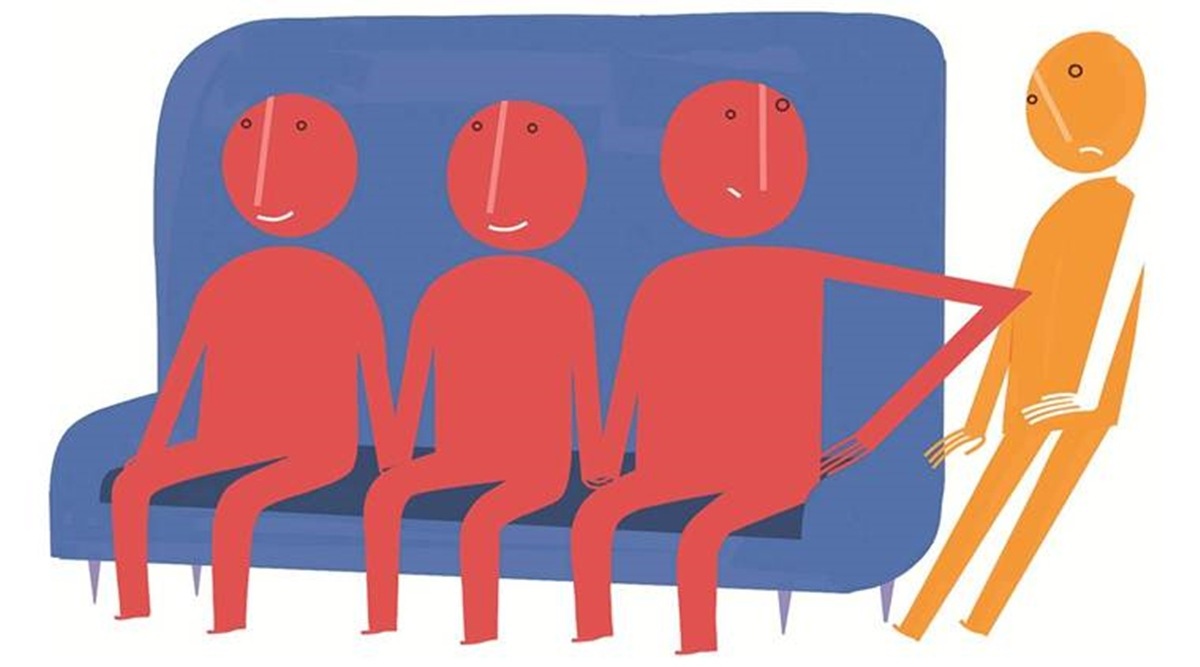 Seeing Dalit children leave the cesspool of dirty villages and exploring opportunities in cities through education and job have left them at a loss. (Illustration by C R Sasikumar)
Seeing Dalit children leave the cesspool of dirty villages and exploring opportunities in cities through education and job have left them at a loss. (Illustration by C R Sasikumar)I vividly recall the Golden Jubilee celebrations of India’s Independence. As schoolgoing children, we took part in the exercises of nation-building as Bollywood-inspired songs from the black-and-white era, alongside those from the recently released movie Border, blasted through cone-shaped loudspeakers.
The same year, just a couple months earlier, police officials, led by a Maratha, carried out mass killings of Dalits in Ramabai Ambedkar Nagar in Mumbai. Another incident down south, in Tamil Nadu, known as the 1997 Melavalavu massacre, saw six Dalit leaders being hacked to death in broad daylight by the dominant caste, the Thevars. In Bihar, the landlord Bhumihars of the Ranvir Sena gunned down 58 Dalits in Laxmanpur Bathe. The Ranvir Sena has been outlawed since 1995, yet continues to operate actively, issuing death threats to Dalits. These gory atrocities occurred a few months before or after the Independence Day celebrations.
Twenty-five years later, the nation is asked to observe Azadi Ka Amrit Mahotsav, another of the government’s initiatives to commemorate Independence.
Earlier this year, Jitendra Meghwal, a health worker in Rajasthan, was hacked to death by two Brahmins because he and his mother allegedly “dared to look up” at the Brahmins. In Bengaluru, Vijaya Kamble was in love with a Muslim girl, but her brother Shahabuddin conspired and killed the Dalit over their inter-caste, inter-religious relationship. Shashikant Jatav, an RTI activist from Madhya Pradesh, was beaten up and forced to drink urine. Indra Kumar Meghwal, a nine-year-old boy, was allegedly beaten to death by his teacher Chail Singh because the child is said to have drunk from a pot reserved for the oppressor castes. All of this happened this year.
Subscriber Only Stories
Should we be celebrating a grandfather’s birthday when the grandchild has been killed in the same house? For India’s outcastes and marginalised groups, Independence is an insult. Asking them to celebrate their death is an act of cruelty.
Independence rarely means anything to those still forced to carry night soil on their heads. The quality of Independence comes with liberty and freedom — both of which are still frightening thoughts for Dalits to exercise. A Dalit riding a mare sends shivers of fear in the minds of oppressor castes. A Dalit girl going to school is feared by the entire village, who prohibit her from attending the same.
Sporting a moustache and dressing smart are sights the oppressor castes cannot process. Seeing Dalit children leave the cesspool of dirty villages and exploring opportunities in cities through education and job have left them at a loss.
No matter the price tag of my custom-made designer suits or the member club travel seats in aeroplanes, the oppressor is desperate to see me as a toilet cleaner. They want to find excuses to surpass their fears by finding a reaction that is representative of a failed, irreparable mind.
There cannot be any festivity of national pride when a Dalit child’s touch is feared. For those still in denial, this is another reminder that people religiously hold such ancient practices in current times. How sinister is a nation that devalues a child and considers it pollution? There is no comparison to it.
The government should seriously reflect on the quality of progress it has achieved. It should aggressively push for an anti-caste education curriculum and public dialogues on caste and its menace. The government has to invest and declare a decade towards a caste-free society. Everyone benefits in the struggle against caste, for caste is not just a Dalit or Adivasi problem. It is a subcaste problem, and all jatis suffer their share but are comforted at the sight of a dying Dalit.
There must be an exhibition of atrocities as well as Dalit memorials to remind the nation that such unwarranted incidents continue to occur. Since the Dalit community is resourceless, they have not been able to make much progress with independent museums. But with the aid of government or private entities, a national healing programme can be instituted for the nation to confront its truths. Almost all victims in the world have a government-backed education, memorialization and cultural programme. The Dalits are the only group with such a vast number and deeper history who do not have an archive of untouchability for public attention. Like the apartheid museum in South Africa, India needs a museum of untouchability.
Suraj Yengde, author of Caste Matters, curates the fortnightly ‘Dalitality’ column